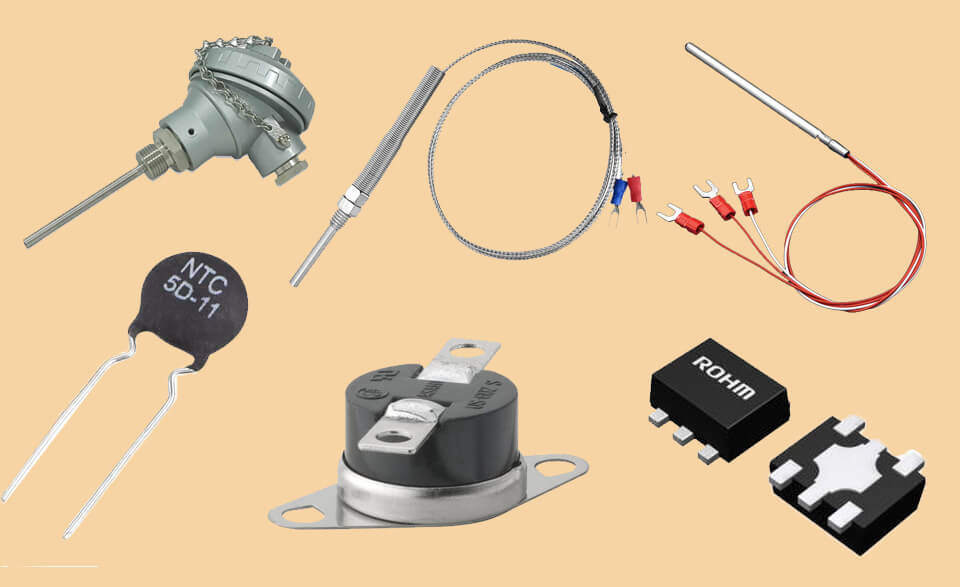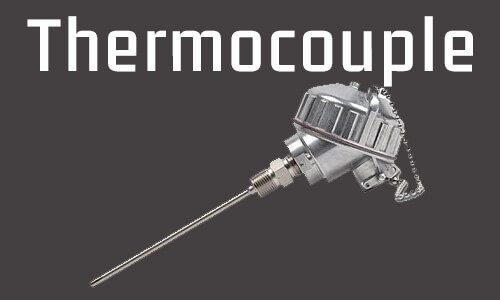Types of Temperature Sensors (RTD, Thermocouple, Thermistor, Semiconductor, Thermometer)
RTD or Resistance Temperature Detector
RTD or Resistance Temperature Detector is a temperature sensor whose resistance varies directly with temperature. They are basically the metal counterpart of thermistors. These precise temperature sensors are built of high-purity conducting metals like platinum, copper or nickel wound into a coil.
The RTD's electrical resistance varies as a function of temperature similar to that of a thermistor. RTDs are in many different forms, such as thin film or wire-wound for greater accuracy. Platinum RTDs provide a highly accurate linear output but the disadvantage of using this type of instrument is that it is more expensive than copper or nickel. RTD uses simple methods such as applying a constant current, measuring the output voltage, and determining the resistance of RTD to measure the temperature.
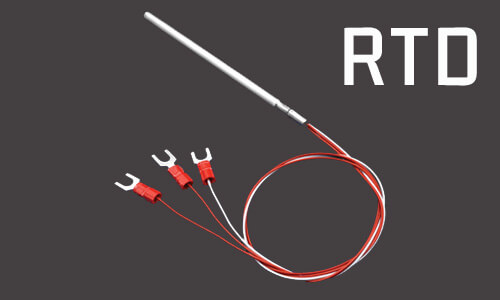
RTDs have positive temperature coefficients or PTC, but unlike the thermistor, their external voltage or output is extremely linear, generating very accurate and precise measurements between temperature sensors. But they have very low thermal sensitivity, which means a change in temperature only produces a very small output change, for example, 1 Ω/°C.
Platinum Resistance Thermometer or PRT is the more common type of RTD built of platinum. The most commonly available type of PRTs is the Pt100 sensor with a standard resistance value of 100Ω at 0 °C that uses its evaluation board to use plain mount RTD for measuring temperature. An external 2, or more-wire PT100 is suitable for measuring temperature in remote locations. The current magnitude is always low to minimize self-heat based on power dissipation.
The RTD is a passive resistor like the thermistor. By passing a current through a temperature sensor, it is possible to obtain an output voltage that changes linearly with temperature. A typical RTD has a base resistance of about 100 Ω at 0 °C, rising to about 140 Ω at 100 °C and its performance range is between -200 to +600 °C. Since RTD is a resistive component, current must flow through it and the resulting voltage must be monitored.
However, any change in resistance due to the heat of the wires (because of the passage of current) according to I2R (Ohm's Law) will cause a reading error. To prevent this problem, RTD usually connects to a Wheatstone bridge network. So, additional connecting wires are used to compensate or connect to a constant current source.
RTD standards
The European standard is also known as the DIN or IEC standard and the American standard are two standards for platinum RTDs. For platinum RTDs, the European standard is the worldwide standard.
According to DIN/ IEC 60751 (or simply IEC751), the RTD requires having an electrical resistivity of 100.00 O at 0 °C and temperature resistance (TCR) of 0.,,385 O / O / °C ranges between 0 and 100 °C.
There are two resistance tolerances determined in DIN/IEC751:
Class A = ±(0.15 + 0.002*t)°C or 100.00 ±0.06 O at 0ºC
Class B = ±(0.3 + 0.005*t)°C or 100.00 ±0.12 O at 0ºC
Two resistance tolerances employed in the industry are:
1/3 DIN = ±1/3* (0.3 + 0.005*t) °C or 100.00 ±0.10 O at 0 °C
1/10 DIN = ±1 /10* (0.3 + 0.005*t) °C or 100.00 ±0.03 O at 0 °C
The most common resistance material for RTDs
RTD Can be made of different and high-purity conducting metals such as:
- Platinum makes up the most accurate and popular RTDs
- Nickel and Copper, are not as stable or repeatable as platinum
- Balco and Tungsten, that rarely used
Applications of RTD
RTD sensor is used to measure the temperature in a wide range of applications and industries such as power electronics, automotive, computer, consumer electronics, food handling and processing, industrial electronics, medical electronics, military, and aerospace.
Glossary For RTD
- RTD (resistive temperature detector)
RTD stands for resistance temperature detector and is a device that works based on the principle of changing electrical resistance in the wire as a function of the temperature.
- Platinum RTD
Platinum RTD, known as the Pt, is usually the most stable, linear, and the most accurate RTD. Platinum is the best way to satisfy the need for accurate thermometry.
- Thin Film RTD
A thin film RTD is built of a thin layer of base metal embedded into a ceramic substrate and is used to generate the desired resistance value. Thin-film elements are in compliance with European curve/DIN 43760 standards and the "0.1% DIN" standard tolerance.
- Class A RTD
Class A RTD is the Highest RTD Element tolerance and accuracy, Class A (IEC-751), Alpha = 0.00385
- Class B RTD
Class B RTD is the Most Common RTD Element tolerance and accuracy, Class B (IEC-751), Alpha = 0.00385
- RTD Element
RTD Element is the Sensing part of the RTD which can be built most commonly of platinum, nickel, or copper.
The thermocouple temperature sensor is one of the most important and widely used temperature measuring tools in industrial environments. Thermocouples are popular sensors because of their ease of use and speed of response to temperature modification (due to their small size).
These sensors also have the greatest temperature range of -200 °C to +2000 °C. Thermocouples are thermoelectric sensors that are basically made up of two junctions of different metals such as copper and constantan. The two metals are welded or pressed at the junction.
The principle of thermocouple operation is that one junction is maintained at a constant temperature, which is called the reference junction (cold) Which is connected to the controller to measure the voltage generated, while the other is the measurement junction (hot) that is placed in the desired environment to measure temperature.
When two junctions have different temperatures, a voltage difference occurs that is used to measure temperature.
Thermocouple Construction
The operation principles of a thermocouple are very simple and basic. When junctions of two dissimilar metals, such as copper and copper, melt together, a thermoelectric effect is produced, which results in a constant potential difference of about a few millivolts between them. The voltage difference between the two junctions is called the "Seebeck effect".
In this case, an emf (Electromotive force) is generated. As a result, the output voltage of a thermocouple is a function of temperature changes. If both junctions are at the same temperature, the potential difference between the two junctions will be zero.
In other words, we will not have an output voltage, because V1 = V2. Of course, when the joints are in the same circuit and have different temperatures, the output voltage will be proportional to the temperature difference between them, V1 – V2. This voltage difference will increase according to the temperature; Until we reach the peak voltage level, which is determined by the characteristics of the two unlike metals used.
Thermocouple Color Codes
Thermocouples have different types made of different materials that enable us to have a temperature range between -200 °C to over +2000 °C.
With such a wide range of choices, international standards have been set for the different thermocouple colors codes, which gives the user the ability to select the appropriate thermocouple sensor for a specific application. So, In order to identify the types of thermocouples, their color can be used.
The three most common materials used in thermocouples for measuring temperature are iron-constantan (type J), copper-constantan (type T), and nickel-chromium (type K). The output voltage of a thermocouple is very small, about a few millivolts for a 10 °C change in temperature difference. That is why it is necessary to use an amplifier.

The amplifier, whether discrete or operational, must be carefully selected, as the thermocouple must have good stability and not need to be recalibrated. This makes choppers and instrumentation amplifiers a better choice for most temperature measurement applications.
The Most Common Applications for Thermocouples
Thermocouples are known as temperature sensors because of their versatility, so they are commonly used in a wide range of applications, from industrial processes to conventional processes.
Electric power generation, furnace monitoring and control, food and beverage processing, automotive sensors, aircraft engines, rockets, satellites, and spacecraft are some examples of thermocouples applications.
a measurable output voltage.
For this reason, these sensors are usually placed in series with a suitable bias resistor to form a voltage distribution network. The output voltage will correspond to pre-set values or temperature points.
Thermistor
The thermistor is another type of resistance sensor for measuring temperature and, as its name implies, is a combination of THERM and ISTOR the former indicates its sensitivity to temperature and it is a type of resistor whose physical resistance varies with changes in temperature. Thermistors are made of semiconductor materials and their resistance is temperature-sensitive.
In other words, a thermistor is a specific type of resistor that changes its amount of physical resistance when exposed to temperature variations similar to the RTDs.
Thermistors are usually made of ceramic materials such as nickel, manganese, or cobalt oxides covered with special glass surfaces, so they can be easily damaged.
The main advantage of these sensors over different types of snap-action thermostats is their speed of response to any temperature variations as well as their accuracy and reproducibility.
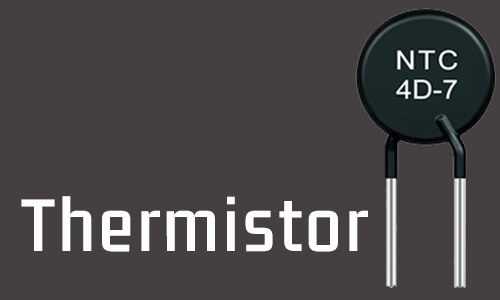
NTC (Negative Temperature Coefficient) & PTC (Positive Temperature Coefficient) Thermistor
Thermistors are divided into two categories; Negative Temperature Coefficient thermistors (NTC) or Positive Temperature Coefficient (PTC)
Most thermistors present a negative resistance temperature coefficient (NTC).In this way, their resistance decreases with increasing temperature. Therefore, in an NTC thermistor, temperature and resistance are inversely related. This type is usually used as an aggressive flow limiter.
In the positive temperature coefficient (PTC) type, the amount of resistance increases with increasing temperature. Hence in a PTC thermistor, the temperature and resistance are inversely proportional. This type is used for protection against high currents or for use in resettable fuses.

As mentioned, thermistors are made of a type of ceramic type semiconductor using metal oxide technology such as manganese, cobalt, nickel, and. The semiconductor material is usually in the form of small discs or compact balls that are sealed to respond relatively quickly to temperature changes.
Thermistors are specified with the amount of resistance at room temperature (usually 25 °C), the time constant (reaction time to temperature change), and the rate of their power to pass current.
Similar to resistors, thermistors are available from 10’s of MΩ down to just a few Ohms at room temperature, but are usually used in kilo-ohms for measurement purposes.
Thermistors are passive resistive components, meaning that current must flow through them to produce a measurable voltage output.
- for lower temperature use, coated in Epoxy [typically -50 to 150°C (-58 to 316°F)]
- for higher temperature applications, coated in Glass [typically -50 to 300°C (-58 to 572°F)
These coatings are used for the mechanical protection of thermistors and wire connections while protecting against moisture or corrosion.
Thermistors are typically provided with very small diameters (#32AW or 0.008" diameter) and solid copper or copper alloy wires. Many times, to have easy soldering, these wires are tinned.
The most common Thermistor Resistance
Thermistors are produced in all forms of resistance and "curves". The resistance is normally determined at 25 ° C (77 ° F).
The resistance of NTC thermistors decreased with increased temperature. This is also true for the degree of change of resistance at any degree to which it produces.
Relatively low-temperature applications (-55 to approx 70°C) usually utilize lower resistance thermistors (2252 to 10,000Ω). Higher temperature applications typically use the higher resistance thermistors (above 10,000Ω) to optimize the change of resistance at each degree at the required temperature.
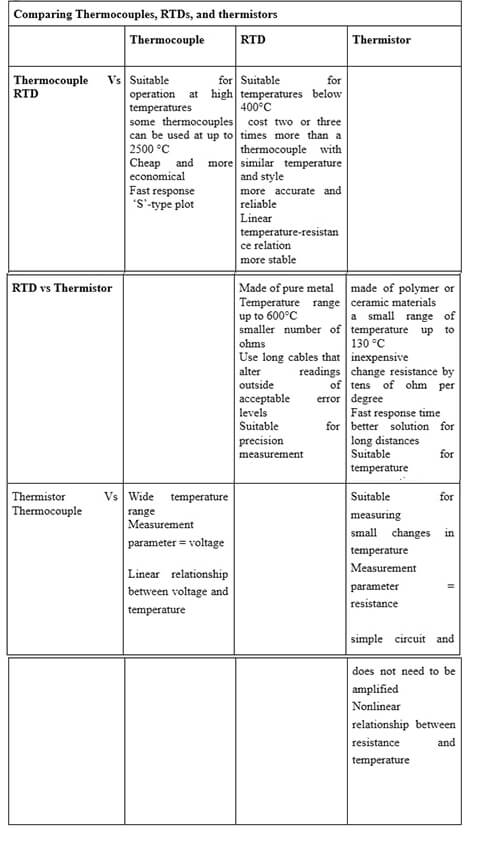
Advantages and disadvantages of thermocouples, RTDs, and thermistors
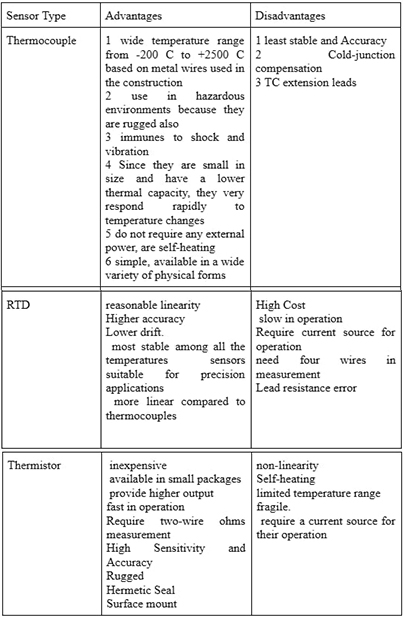
Application
Thermistors are available in a variety of sizes and are simple to use, therefore they can be used to control and measure temperature in a range of applications from domestic to different industries.
- Thermistor Applications - Domestic (White Goods) - Thermistors are very popular to monitor and measure temperature. you may be wondering to know the number of devices within a home environment that use thermistors for sensing purposes.
- Some examples of these applications are;
- Microwaves/ Boilers - thermistors monitor the internal temperature and prevent it from becoming too hot.
- Circuit protector - thermistors control the fluctuations of power and make sure that the correct amount is driven through a device that is attached.
- Digital thermometers - thermometers often use thermistors as an element of temperature measurement because they have a quick and accurate response.
- Thermistor Applications - Commercial
- Vehicle cabin heat - thermistors are often used to ensure that the vehicle remains at the right temperature.
- Manufacturing - thermistors are used as "circuit breakers" at the production facilities; If the temperature increases dangerously, the thermistor causes the circuit to be disconnected.
- HVAC refrigeration applications - thermistors are used to measure the manufacturing and control processes that increase control and efficiency.
- 3d printers - thermistors are used to set temperature because they have to be controlled accurately.
- Medical applications - When accurate temperature monitoring is necessary, a thermistor is used because it is very sensitive and indicates if the temperature changes only slightly. They can be used for patient monitoring, dialysis equipment, and catheters.
- Food & Beverage Industry - within the environments of the handling and processing of food/ beverage, thermistors can be used to monitor the temperatures to make sure that it is kept at the correct temperature.
Semiconductor
![]()
A semiconductor-based temperature sensor known as an IC temperature sensor is an electronic device that is vastly used in ICs or integrated circuits.
These sensors include two similar diodes with high sensitivity that are used to monitor temperature variation. They precisely supply electrical characteristics, including voltage and current, to measure the temperature changes.
They also have the slowest time responses between 5 to 60 s between temperature sensors in their temperature range. semiconductor-based sensors are also suitable for use in cold-junction compensation circuits for wide temperature range thermocouples.
The AD590 and the LM35 have traditionally been the most popular temperature sensors. They are grouped into different broad categories such as voltage output, current output, resistance output, digital output, and diode types. A summary of these types of semiconductor temperature sensors is presented below.
- Voltage Output Temperature Sensors
Voltage Output sensors offer a voltage output signal with a relatively low output impedance. These linear output sensors need an excitation power source.
- Current Output Temperature Sensors
The current output sensors operate as a constant current regulator with high impedance, which typically passes 1 micro-amp per degree Kelvin and needs the supply voltage between 4 and 30 volts.
- Digital Output Temperature Sensors
The first sensor to integrate a sensor and an analog to digital converter (ADC) onto a single silicon chip is a digital temperature sensor. These sensors are not considered suitable for use with standard measuring devices due to their non-standard digital interfaces. Many of them are specially designed for the thermal management of the microprocessor chips
- Resistance Output Silicon Temperature Sensors
The properties of the temperature resistance against the bulk of semiconductor materials enable the production of simple temperature sensors using equipment of standard silicon semiconductor fabrication. This design can be more stable than other semiconductor sensors because of greater tolerance toward ion migration.
- Diode Temperature Sensors
The Diode Temperature Sensors use ordinary semiconductor diodes as temperature sensors. The diode is the least expensive temperature sensor and can provide more satisfying results if you are prepared for a two-point calibration and present a steady and stable stimulation flow.
Its measuring circuit is simple and The forward-biased voltage across a diode provides a temperature coefficient of about 2.3mV/°C and is linear.
Conclusion
Semiconductor sensors make use of new materials and processes to replace the complicated and costly conventional sensors.
They feature Linear characteristics, and small size, and are used for several applications such as navigation systems, optical devices, motion sensors, as well as health monitors.
Also alongside the technical features, sometimes cost is the key factor in selecting the proper device, low cost is one of the significant advantages of diode temperature sensors.
Thermostat
Thermostat is an electromechanical mechanical sensor or switch that basically made up of two different metals, such as nickel, copper, tungsten, aluminum, etc., which are joined together to shape a Bi-metallic strip.
When the strip is exposed to heat, due to the different values of the linear expansion of these two dissimilar metals, mechanical bending motion will occur in the metals.
The Bi-metallic strip alone can be used as a switch, electric switch, or a mechanical solution for the operation of the electrical switch in thermostatic controls.
They are used to control water heating elements in boilers, furnaces, hot water storage tanks as well as vehicle radiator cooling systems.
Bi-metallic Thermostat
The thermostat is made up of two different metals (in terms of thermal characteristics) that are connected back to back. When it is cold, the contacts are closed and current flows through the thermostat. But when it gets hot, one metal expands more than the other, and the Bi-metal strip bends up (or down), preventing current from flowing through the thermostat when the contacts open.
There are two types of Bi-metallic strips depending on the type of strip movement that is exposed to temperature changes. One type is "snap-action", which performs an instantaneous “ON/OFF” action at a specific temperature point. Another type of thermostat has a "creep-action" and the position of its contacts gradually changes with temperature changes.
snap-action thermostats are commonly used in homes to control the setting point of stoves, irons, and hot water tanks, as well as can be found on walls to control the home heating system.
Creeper-action thermostats are usually made of Bi-metallic coils or spirals that coils-up slowly as the temperature changes. Usually, the creeper type is more sensitive to temperature changes than the standard on/off type, because the strip is longer and thinner, and therefore this type of thermostat is an ideal option for use in thermometer gauges and dials, etc.
Although Snap-action thermostats are very cheap and available for a wide range of operations, one of their main disadvantages, when used as a temperature sensor, is that there is a large range of hysteresis during open to closed electrical contacts.
For example, the thermostat may be set at 20∘C, but contacts do not open until 22∘C and until 22oC or close again until 18oC. Therefore, the range of temperature fluctuations can be very high. Bimetallic thermostats on the market for home use can be adjusted using a screwdriver, thus achieving the desired temperature and resetting the hysteresis level.
Application
Thermostats find application in a variety of industries and products, of heating, refrigeration with defrost, solar heating, timing and humidity, and temperature control.
Thermostats operate as the control unit for HVAC systems including boilers, furnaces, electric heaters, central air, space heaters, or other instruments that set ambient air temperature. Thermostats are found in the following cases:
- Installation devices and systems: Thermostats are used in the mechanical installation industry to control the temperature of water or air in refrigeration and heating systems. Radiators, boilers, and fan coils are the most common devices that use thermostats to control temperature.
- Vehicles
- Home Appliances: for example, the thermostat is designed to keep the temperature of a refrigerator constant. It regulates the temperature inside the refrigerator, in other words, the temperature is regulated by the thermostat, which issues the command to turn off and on the compressor. For example, when the thermostat lever is set to 6, the thermostat allows the compressor to operate until the refrigerator temperature reaches 6 degrees Celsius, and when the refrigerator temperature reaches 6 degrees Celsius, it automatically shuts off the compressor thermostat to maintain the temperature at this level.
Digital thermostat
With the advancement of technology, thermostats are used to intelligently control the temperature of homes and offices. The digital thermostat receives the desired temperature from the user and compares it with the ambient temperature. Then, according to the temperature difference that it has measured and the temperature that the user has specified for it, it controls the cooling and heating systems such as fan coil, duct split, package, etc.
Infrared sensor (IR sensor)
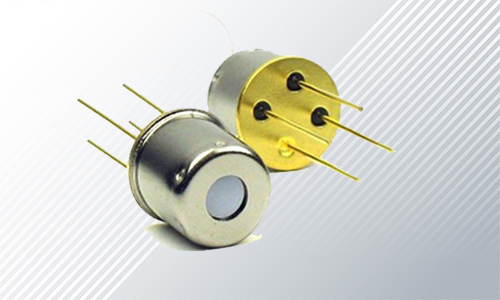
The IR sensor is an electronic device used to detect certain characteristics of the surrounding environment by emitting IR radiation. These sensors are non-contact sensors that detect the temperature of the desk based on the merit of its radiation. There are two types of IR sensors including thermal infrared sensors and quantum infrared sensors.
The sensor works based on the focusing infrared energy emitted from an object on one or more photodetectors.
The photo detectors convert that energy into an electrical signal that is proportional to the infrared energy emitted from the surface of the object.
Infrared sensors are suitable for measuring temperature in a wide range of industrial and clinical environments. They perform well without any physical contact with the object and can be used in circumstances where the object is fragile and dangerous to get near, or when other kinds of thermometers are not applicable.
Thermometer
A thermometer is one of the most important measuring instruments used to determine the temperature of objects or a system. It is used to measure the temperature of solids, liquids, and gasses.
Temperature is an important value to be measured in a wide range of activities, such as production, scientific research, and medical practice.
It is Among the most widely used instrumentation equipment in industries, factories, and refineries. Its name is a combination of the word thermo which means heat, and meter means to measure. In its glass tube, the thermometer has a liquid that is mercury or alcohol.
There is a linear relation between the volume of the thermometer and the temperature - the volume of the thermometer increases as the temperature increases. As the liquid is subjected to heat, it expands into the thin tube of the thermometer.
This thermometer has a calibrated scale to show the temperature. The thermometer has numbers that are marked by the glass tube to show the temperature when the mercury line is at that point. Thermometers are calibrated with standard scales such as Celsius, Fahrenheit, and Kelvin. So, it should always be noted for which scale the thermometer is calibrated.
Digital thermometers use a thermistor with a resistance that changes with temperature. There are other types of thermometers that operate based on sensing sound waves or magnetic conditions associated with temperature variations.
Magnetic thermometers increase in efficiency by decreasing temperature, which makes them very useful in measuring very low temperatures with precision.
Thermal Imaging
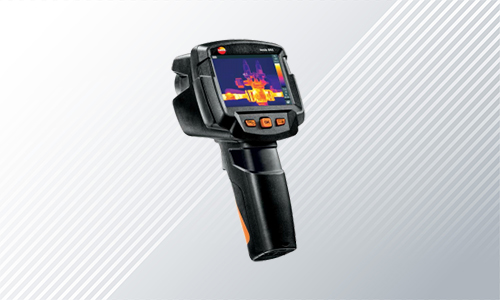
Any object that has a temperature higher than zero generates electromagnetic waves around it. Usually, these electromagnetic waves can be scattered in the environment.
So every object creates temperature around itself. This feature allows the use of cameras that can receive these waves. In thermal imaging, using this feature, it is possible to take pictures of objects.
The process of using thermal imaging cameras to scan the heat produced by objects and shape the image with a range of colors is called thermal imaging.
In fact, in thermal imaging, a particular color is determined for each temperature range, and this feature can be used to detect the condition of the object using its temperature.
A thermal imaging camera is a non-contact measuring device that detects infrared energy (heat) and converts it into a real image of objects.
A thermal imaging camera receives infrared energy and uses the data from the infrared energy to create a digital or analog image. This data is usually displayed on an LCD screen, where different color ranges determine the changes in temperature.
There are different kinds of thermal imaging cameras ranging from handheld devices that fit in your pocket, to handheld cameras for basic thermography up to high-end cameras that can measure high-temperature ranges and clearer high-resolution images.
The key part of a thermal camera is a heat sensor connected to a special type of lens. This lens is adapted to work alongside standard image capture technologies.
This enables engineers to rapidly detect regions of excessive temperature or sources of wasted heat energy, including overheating components or potential thermal insulation gaps in building inspection.
Visible light only forms a small fraction of the electromagnetic spectrum and is the only part we can really see. When referring to an object or area, the sensor on a thermal detection camera enables the user to observe the invisible infrared spectrum that exists in wavelengths between visible light and microwaves.
How do thermal imaging cameras work?

All objects have a thermal signature. In fact, this is the amount of infrared radiation emitted by them and should be measured and detected by a thermal camera.
To do this, the camera must first be equipped with a lens that can receive infrared frequencies and then be able to reflect these frequencies on a special sensor, which in turn can detect and read these frequencies.
The sensor array is made of a grid of pixels. Each pixel of this sensor detects the amount of infrared light it receives, and this sensitivity is converted into electrical pulses.
These signals are then passed to a processor within the main body of the camera, which converts them into a color map of different temperature values by using algorithms. So this map is sent on to be presented by the display screen.
Applications
Thermal imaging in medicine - In medical sciences, body temperature is used for this type of imaging. The application of thermal imaging in medicine is in the field of diagnosis.
Thermal imaging in security - Because there is no visible light in dark environments, thermal imaging is used to detect objects. This feature can be used in military affairs and the identification of people by the police or the detection of wild animals in dark and high-risk areas.
Thermal imaging in the industry - Another application of thermal imaging is in the industry. In various electrical industries, manufacturing of mechanical and industrial equipment, thermal imaging is used to detect damaged parts of devices, loose parts, improper voltages, or abnormal temperatures in temperature sensitive devices.
What is a Temperature Probe?
A temperature probe is a type of temperature sensor. There are several types of temperature probes that are used for various applications in many industries. Some temperature probes can measure temperature by placing them on the surface of the object.
Other devices must be entered or immersed in liquid to measure temperature. Generally, a temperature probe measures voltage changes and converts them to a format that can be monitored by the user.
The temperature probe can be a standard configuration or customized based on the customer's requirements. For example, standard types can be used for more common applications.
In the medical industry, custom temperature probes are commonly used for very specific applications, such as motorsport or engineering.
Different types of temperature probes
1.The NTC- (Negative Temperature) temperature probe uses a thermistor. These are usually low cost, have a small temperature range, but tend to respond quickly and very sensitively.
2.The RTD- (Resistance Temperature Detector) probe has high reliability and long life. This makes them more expensive, but they also offer a wider temperature range.
3.Thermocouples - Thermocouple temperature probes are less expensive than RTDs and provide a wide temperature range, but are unstable over time, so some probes need to be replaced more often.
Industries for temperature probes
Temperature probes are suitable for use in almost any industry. Medical, motorsport, food, and communication are some of the more popular industries that use temperature probes.
Applications for Temperature Probes
Temperature Probes are commonly used in daily life and others are and others are proper for use in certain industries. Industrial equipment, patient controlling, transit, computers, home tools, HVAC, power and utilities, calibration and instrumentation, laboratory, energy, and drilling are only some of the applications of temperature probes.
Tap here to get more information about temperature sensor:
How to Choose a Temperature Sensor?
Everything About Temperature (Units and Unit Conversion)
Common Applications of Temperature Sensors
Click on the following link, in case you need to view our inventory on the Hygrometer. A device used to measure the relative humidity of the air or the amount of invisible water vapor present in a specific environment.
Recent Posts
-
Booster Pump Troubleshooting and Maintenance: How to Fix and Prevent Common Issues
1. Introduction Imagine turning on your faucet only to be greeted with a weak trickle of water when …22nd Apr 2025 -
Energy-Efficient Booster Pumps: Selection and Tips for Maximizing Performance
1. Introduction Imagine never having to deal with fluctuating water pressure, noisy pumps, or skyroc …19th Apr 2025 -
Booster Pumps for Sustainable Water Systems: Irrigation and Rainwater Harvesting Solutions
1. Introduction Water scarcity is no longer a distant threat—it’s a reality affecting millions …16th Apr 2025

